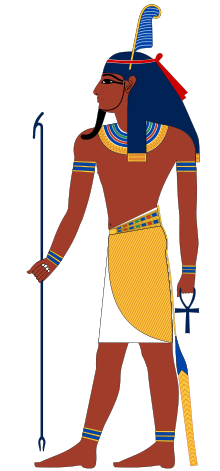Shu (Egyptian god)
| Shu | ||||||
|---|---|---|---|---|---|---|
| God of the wind and air | ||||||

The ancient Egyptian god Shu is represented as a human with feathers on his head, as he is associated with light and air. This feather serves as the hieroglyphic sign for his name. Shu could also be represented as a lion, or with a more elaborate feathered headdress.
|
||||||
| Name in hieroglyphs |
|
|||||
| Major cult center | Heliopolis, Leontopolis | |||||
| Symbol | the ostrich feather | |||||
| Personal Information | ||||||
| Consort | Tefnut | |||||
| Offspring | Nut and Geb | |||||
| Parents | Ra or Atum and Iusaaset | |||||
| Siblings |
Tefnut Hathor Sekhmet |
|||||
Shu (Egyptian for "emptiness" and "he who rises up") was one of the primordial Egyptian gods, a personification of air, spouse and counterpart to goddess Tefnut and one of the nine deities of the Ennead of the Heliopolis cosmogony.
In Heliopolitan theology, Atum created the first couple of the Ennead, Shu and Tefnut by masturbating or by spitting. Shu was the father of Nut and Geb and grandfather of Osiris, Isis, Set, and Nephthys. His great-grandsons are Horus and Anubis.
As the air, Shu was considered to be cooling, and thus calming, influence, and pacifier. Due to the association with air, calm, and thus Ma'at (truth, justice, order, and balance), Shu was depicted as the air/atmosphere between the earth and sky, separating the two realms after the event of the First Occasion. Shu was also portrayed in art as wearing an ostrich feather. Shu was seen with between one and four feathers. The ostrich feather was symbolic of lightness and emptiness. Fog and clouds were also Shu's elements and they were often called his bones. Because of his position between the sky and earth, he was also known as the wind.
...
Wikipedia
